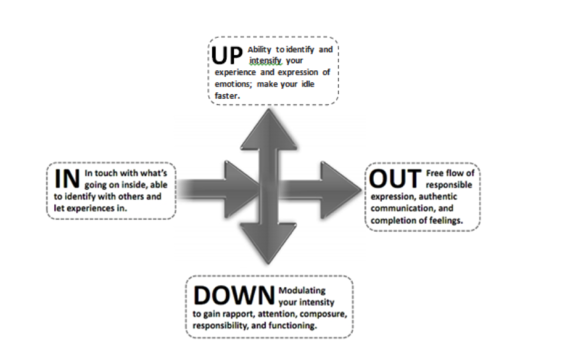I don't want to be at the mercy of my emotions. I want to use them, to enjoy them, and to dominate them. - Oscar Wilde
We know that Emotional Intelligence can be learned, but like everything there's no quick fix. It takes time, commitment and dedication. So, how do we do it? We practice. In Part I of Boost Your EQ series we covered the five components of Emotional Intelligence and how to boost your EQ by taking the "five-day EQ challenge."
In this Part II, you can regulate your emotional intelligence using the in, out, up and down approach and take your EQ to the next level. This week's challenge is to see how much you can vary your experience by practicing each of the four directions.
Practice Regulating To Boost your Emotional Intelligence
Each time you practice the ins, outs, ups and downs of emotional facility, you are increasing your own self-regulation of emotions and improving your Emotional Intelligence, or EQ.
To varying extents, each of us regulate emotions - in, out, up or down - likely hundreds of times a day, consciously and unconsciously.
Source: Transformed! The Science of Spectacular Living, 2012
by Dr. Judith Wright & Dr. Bob Wright
In-Regulating: Go Deeper in Your Body
In-regulation is all about noticing what's going on inside your body. Many of us forget we can feel emotions in our body, or what parts of our bodies feel emotions the most. Does your stomach feel queasy? Is your jaw tight? Are your palms sweaty? Tune inwards to feel the emotion deeper or more fully within yourself. See if you can name the emotion. Pause whatever you're doing and consciously ask yourself, "What am I feeling right now?" Allow yourself to feel which of the five primary emotions is present - joy, sadness, hurt, fear or anger. By doing so, life feels fuller and more real.
Boost your EQ and in-regulate: Pause
- Take three deep belly breaths, preferably through your nose. Tune into your sensory awareness and name what you see, hear, smell, taste and feel. What feeling comes up while doing this? Try to deepen that experience by tuning into your body and noticing how it responds and feels. Don't make judgments about what you feel, simply allow yourself to experience the feeling.
Out-regulating: Express responsibly and flow
As an emotionally and socially intelligent leader, it is important to responsibly express in the moment. Stay in the present moment and express fully to yourself and others. Don't ignore or deny what you want to express. This can be as easy as naming a feeling out loud even if nobody else can hear it like, "I feel frustrated" at work without any blame, shame or drama. Allow what you're experiencing on the inside to flow outwards in a responsible, authentic way. This responsible expression creates engagement connection with others and myself.
Boost your EQ and out-regulate: Express fully
- Take a moment today and express your thoughts and feelings about something or someone. Stay in the present moment, and allow yourself to feel vulnerable and share.
Up-Regulating: Intensify your Emotions
Up-regulating is all about heightening your own self-awareness and taking action to intensify what you're experiencing in the moment. Feeling happy or joyful? What could you do to experience that even more? Feeling a little sad? What could you do to allow yourself to express more fully so you can move through and complete it? The idea is that you can amplify on the outside what you're feeling on the inside. As a result you can develop a wide range of responsible expression. It's almost as if you have a faster idle so you can take off more quickly.[i]
Boost your EQ and up-regulate: Intensify your experience.
- The next time you notice an emotional response, ask what you can do to intensify that experience? If you are happy because you are smelling a fragrant bouquet of flowers, can you sniff them again or inhale deeply? If you are biting your lip because you are sad about something that happened, can you feel it more in your body and express?
Down-regulating: Keep Calm and Carry On
Down-regulating is about the ability to self-soothe and calm yourself from an intense emotional state. Down-regulating doesn't mean ignoring an emotion, or numbing out and eating your favorite comfort food, or whatever brings you short-term comfort. Down-regulating comes in handy if you are feeling a particular way and it's not appropriate to express in a wild and crazy way at that moment.
Neurologically, when you are soothing yourself or trying to be calm, your limbic system, or emotional center of your brain, is actually working hard to feel comforted and affirmed as a result of experiencing intense emotions. To honor that, it's important to practice getting comfort or affirmation from yourself or even better, someone else. Begin by kindly talking to yourself and taking some calming or soothing techniques that calm your emotional state.
Boost your EQ: down-regulate: Calm & Soothe Techniques
- Connect with a person, place or thing. Look at a photo that helps you feel more secure and calm. Looking at a picture of my last vacation spot, a child, or a pet works wonders. This works great whether I'm feeling stressed out or if I'm jumping for joy. You may feel uneasy, but know that it's ok to feel this way even if it is uncomfortable.
Learn what works for you. I challenge you to do it for four consecutive days, focusing on one of the four ways a day. Experiment and see what you have a knack for, and which ones are out of your comfort zone. Don't be afraid to make it playful and fun.
Leave me a comment for what works or didn't work for you.
References
[i] Wright, Judith, and Bob Wright. "The Heart of Transformation." In Transformed! The Science of Spectacular Living. Nashville: Turner Publishing, 2012.


